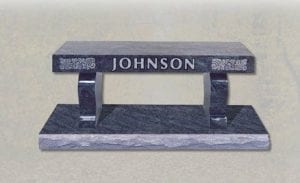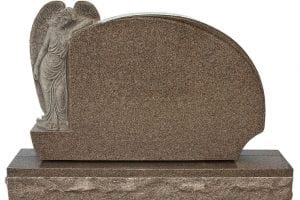How to Buy a Grave Marker
Designing Your MemorialBecause a grave marker is a permanent memorial, many people find the process of selecting one daunting. That is perfectly understandable. To make matters worse, it is a large purchase, and if you are working with a salesperson, you may be presented with options you aren’t sure you want or need.
Our Grave Markers, Memorial, and Monuments page offers helpful tips on how to shop for a marker. This page will provide a primer on:
- The types of markers most commonly used
- The materials used for grave markers
- And what to consider when designing a marker
Types of Grave Markers
The words grave markers, headstones, and gravestones are often used interchangeably. In general, these terms can refer to any type of memorial that is placed on a grave. Cemeteries will often use the term “monument” to refer to any upright memorial. “Markers” generally refer to memorials that lie flat or are beveled. The type that is best for you will depend on your cemetery’s requirements, your personal taste, and your religious or cultural customs. Most styles of grave markers are available for one person or in a “companion” style. Companion markers are made for two people. A common design is to have the family name engraved at the top and the details for the individuals below that, side-by-side.
Monuments
Upright Headstone: Upright headstones made of granite are the most common monuments that we see today. These have two pieces–a top and a base. The top is often shaped like a tablet or rectangle, but they may also be curved, wavy, or some other shape.
Slant Marker (or Headstone): Like an upright headstone, a slant marker will normally have a top and a base, but they may also be placed directly on the lawn. The top will be wider at the bottom and have an angled top that tapers so that the front is seen at a slant.
Benches: Memorial benches are typically made of granite and are sometimes used as an alternative to a traditional grave marker. They may also be used along with a marker. Benches are available in various colors and styles and may be made with or without a seatback. If you plan to incorporate a bench in your memorial, it is important to check with your cemetery since many have rules regarding placement.
Obelisks: Obelisks are tall, column-like monuments that typically have four sides. These are mounted on a thick square base.
Markers
Flush, Flat, or Lawn-Level Marker: Lawn-level markers are small markers set flush on the ground or just a few inches above. This type of marker is made of granite or bronze. Granite versions come in a variety of colors and finishes. “Memorial park” refers to cemeteries that only allow flush memorials.
Ledger Marker: Ledger markers are granite or bronze slabs that cover the entire gravesite. They are sometimes used along with a headstone.
Grave Marker Materials and Styles
An important element in learning how to buy a grave marker is understanding the materials most commonly used today. Markers are available in various materials, but the most common are granite, bronze, or a combination. These materials are economical, long-lasting, and easy to maintain. Both are easy for artists to work with, allowing for various designs ranging from simple and elegant to extravagant and detailed. It is important to check with your cemetery to determine if it requires a certain type of grave marker. A granite headstone may be appropriate in one part of the cemetery, but bronze may be required in another, such as a memorial garden.
Granite
Granite is an extremely hard, igneous rock composed of quartz, mica, and feldspar. The qualities that make it an excellent stone for building structures make it a preferred material for crafting memorial stones. Its strength makes it durable, long-lasting, and able to withstand harsh weather. It is available in shades like gray, pink, blue, black, and green.
Due to its natural properties, granite can be polished to a beautiful shine, and its surface is finished in many ways. This makes it the perfect material for personalizing. Modern carving techniques that use diamonds and carbide allow the craftsmen who create grave markers to engrave the stone with virtually any design.
Bronze
Bronze is an alloy made primarily of copper and other metals such as tin. Once combined, these metals become one of the hardest materials available. This makes bronze extremely durable and desirable for use in grave markers. The actual marker is created by heating the bronze to an extremely high temperature until it liquefies and then passing it through a mold. The mold contains the personalization. After the molding process is complete the marker will be fine-tuned by a craftsman who evens out imperfections and applies a brown tinting to the background. Over time, bronze will develop a green patina. To some, this is unsightly, while to others, it enhances the beauty of the marker.
Other Materials
If you wander through old cemeteries, you will likely see stones and markers made of slate, marble, and fieldstone. Some specialty providers will still produce markers in these materials, but many cemeteries won’t permit their use since they do not stand the test of time.
Slate is easy to carve but doesn’t hold up well to weather since it is a relatively porous material. Marble, though beautiful, is expensive and also tends to deteriorate quickly. Other materials, such as fieldstone, limestone, and sandstone, can make beautiful stones but do not weather well.
Designing a Grave Marker
Regardless of the type of marker you select, you will normally include the deceased’s name, date of birth, and date of death. In addition to this information, you have many options for enhancing your tribute. Should you have a photo? How about an illustration or quote? Should you use humor? All of these can be tough questions. To help the design process go more smoothly, consider these five questions before you get started.
- What does the cemetery require? Your cemetery may only permit the person’s name, dates of birth and death and a short quotation. If this is the case then you won’t need to decide on a graphic or illustration.
- What type of marker are you buying? If you know what type of marker you will be purchasing it will be much easier to design your memorial since the size and type will determine how much information you have room for.
- What would the deceased prefer? The best place to start when designing is to think about the person you will be memorializing. What was his or her personality like? If you are designing for yourself then that part is easy. Once you have thought about the person you can zero in on the type of memorial design that is appropriate.
- Can you afford it? Some features add to the cost of the stone or marker. Knowing how much you’d like to spend will help you determine priorities for what you can add to the memorial.
- What should it say? The most important factor in determining what is appropriate for the person you are memorializing is to remember that the words or phrase is meant to honor the person. It is also something that will be “etched in stone.” So keep your inscription short and relevant to the person’s life. Perhaps they have a favorite poem or quotation that you think would be appropriate. If not, you can find many suggestions on the Internet, in your public library, or through a local funeral home or cemetery. Scripture references are also commonly found on grave markers. Below are some examples of typical grave marker inscriptions. Of course, you are not limited these. What you decide to have etched on the stone is totally up to you. “Loving father, son, soldier” “In memory of…“ “The Lord is my shepherd; I shall not want. –Psalm 23” “Beloved daughter” “Gone, but not forgotten” “Forever in our hearts“
- Select artwork or illustrations. There are many options when it comes to selecting artwork for use on granite memorials. The company through which you are purchasing your marker will probably have a list of graphics that they can accommodate on your stone. Due to size, your options will be more limited on smaller granite or bronze markers. Remember that what you are designing is intended to be a tribute to a person’s life and personality. Some of the more popular symbols include flowers, angels, birds, praying hands, and symbols such as alpha & omega, an ankh. In addition to traditional symbols, many people opt to include images that bear a relationship to groups or organizations with which the person being memorialized were associated. Examples of these would be the symbols of the branches of the military, masonic symbols, animal illustrations, and sports-themed logos.
When it is all said and done, you will have a beautifully designed grave marker that creates a lasting tribute to you or your loved one.





